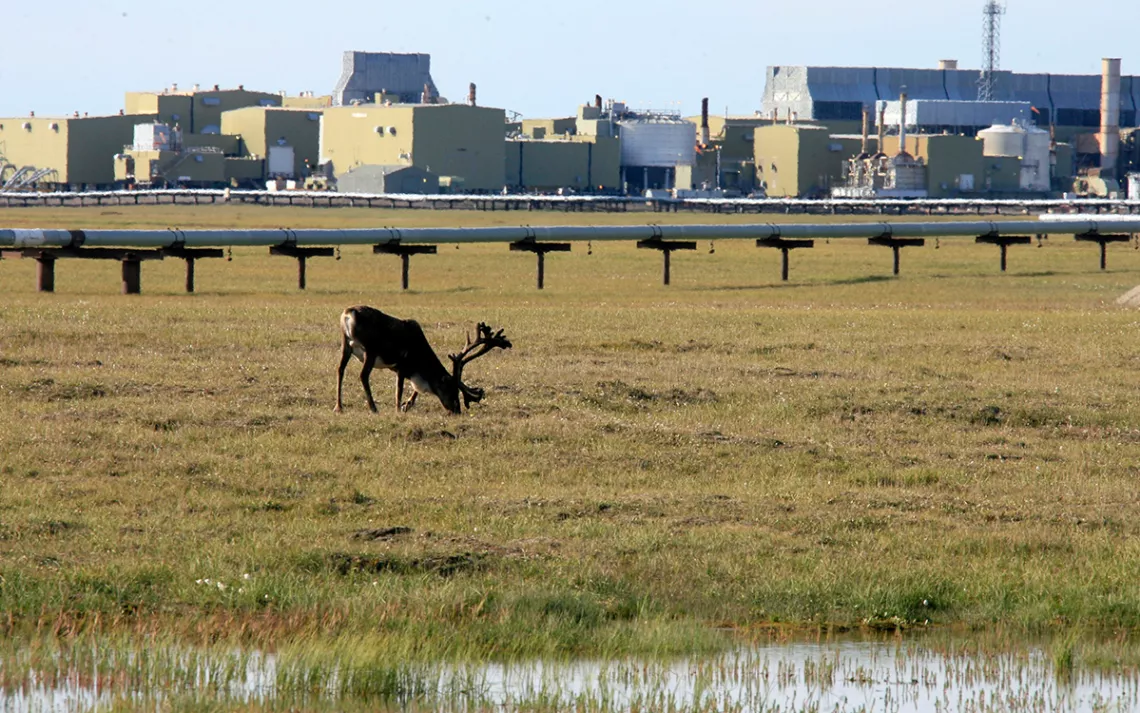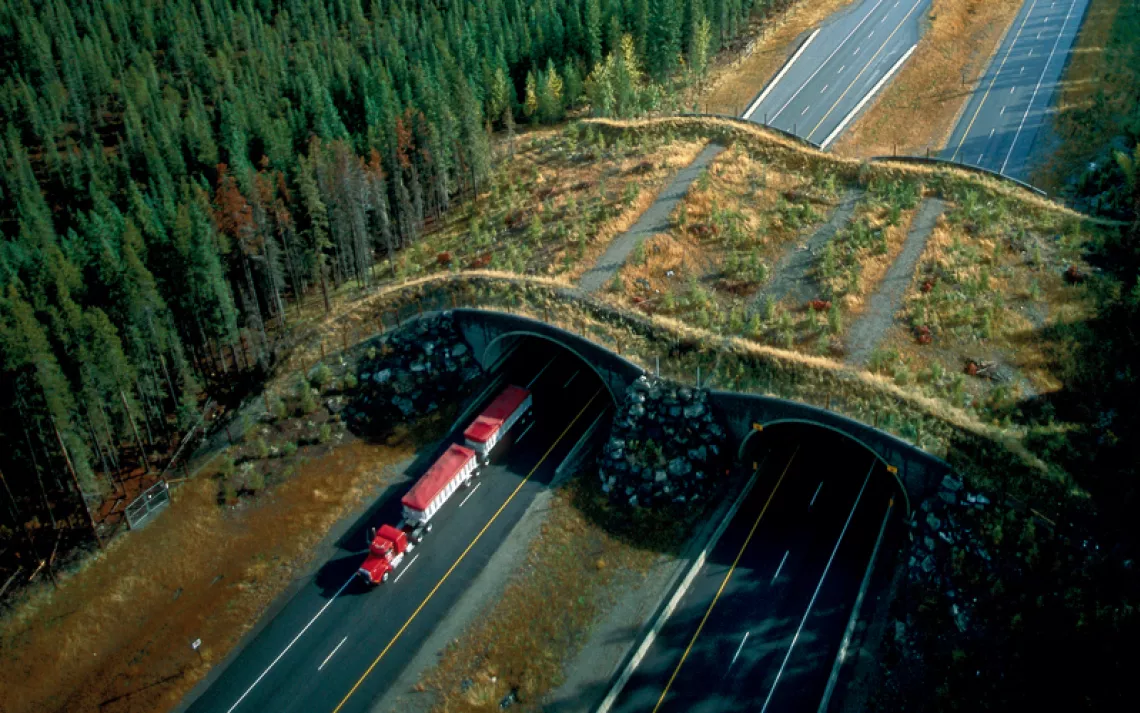The United States Is Not a Party to a Global Treaty to Protect Wildlife
But it still plays a big role in helping to draft the UN biodiversity framework

A caribou grazes near oil transit lines running across the tundra on Alaska's North Slope. | Photo by Al Grillo/AP
As governments from around the world wrap up the second week of talks to save millions of species from extinction, one essential country is missing from the negotiating room: the United States. Despite having helped draft the Global Biodiversity Framework, the US is not an official member of the Convention on Biological Diversity (CBD), a United Nations treaty meant to stop and reverse the decline of wildlife.
To become a party to the treaty, 67 senators would need to ratify it, but experts familiar with the framework say that’s not happening anytime soon. “There's been no way to get two-thirds of the Senate,” said Susan Lieberman, the vice president of international policy at the Wildlife Conservation Society. “Now, I should say it’s close to impossible, if not impossible.”
That doesn’t mean the US doesn’t have a role to play. A large US delegation that includes Monica Medina, the US special envoy for biodiversity and water resources, arrived in Montreal this week with a host of high-profile officials from the White House, Department of Interior, National Oceanic and Atmospheric Administration, and US Geological Survey. While none of these officials will be able to negotiate as a formal party to the convention, they are playing a crucial role in building consensus and getting the agreement across the finish line. Like many stakeholder groups, including NGOs, subnational governments, and businesses, American delegates are influencing the talks through an array of side events, roundtables, and private meetings.
Their goal? Helping countries winnow down the alarming number of brackets, indicators of unresolved text, in the framework. Governments need to first reach consensus on the language for the draft to be finalized. In addition, they’re also ensuring countries agree on specific targets by bridging the gap between what opposing delegates want, such as calls from the Global South for countries in the Global North to boost conservation funding.
“Although the US is not a member of the CBD, we believe that we can have a very positive impact on the negotiations,” said Medina during a press briefing before flying to Montreal. “We’re working closely with our allies, governments that see these issues like we do, and we hope to help them resolve differences, close down some of the open text and just use our expertise.”
One of the areas where that expertise is expected to be most useful is 30x30, a plan to conserve 30 percent of the world’s land and oceans by 2030. With its singular focus, the 30x30 target has become perhaps the most famous in the draft framework. Already, 120 countries, including the United States and Canada, have committed to the goal. Medina has said that encouraging other countries to embrace this goal will be a priority of hers and the other delegates while they are in Montreal. On the ground, this means experts from various agencies will serve as advisers to negotiating partners, helping them figure out how to finance and implement the conservation target.
“A lot of times, it just takes teamwork to fan out and make sure we understand all the issues with respect to every single place in the text that's bracketed,” Medina told Sierra. “And the more we can eliminate those brackets sooner, the better we can get down to the real issues, which are probably, how do we actually implement 30x30, this ambitious framework that we hope to see adopted? And how do we finance it?”
The last part will be another critical issue in which the United States is expected to play a crucial role. As a country, it is one of the largest contributors to environmental funding, said Mark Opell, the finance lead for Campaign for Nature. This year alone, through a multilateral environmental fund called the Global Environment Facility, the US has committed $600 million over the next four years.
Continued and increased funding such as this could go a long way in helping developing countries achieve the ambitions set forth in the Global Biodiversity Framework, say conservation groups. “The experts have identified a financing gap in the world of biodiversity conservation of somewhere between $500—$900 billion per year,” said Zak Smith, the director of the Natural Resources Defense Council’s global biodiversity conservation program. “You can close the financing gap, in part through reforming environmentally damaging subsidies.”
However, reducing harmful subsidies alone wouldn’t be enough. To bridge the gap, a combination of public, private, and philanthropic funds would need to be leveraged to meet the full needs of conserving nature.
One issue not being talked about by the American delegation is a National Biodiversity Strategy. Conservation groups say the Biden administration could build on what’s already been done by creating one. While they vary across the 194 nations that have adopted them, they typically include similar metrics—an assessment of the country’s plants, animals, and ecosystems, with further measures that outline ways to protect and conserve the most threatened species.
The idea started to gain traction last year when Representative Joe Neguse, from Colorado, introduced a bill that would create a biodiversity strategy, but the bill was never brought to the floor for a vote. Since then, a coalition of 120 conservation groups, which include Defenders of Wildlife and the World Wildlife Fund, has been calling on President Biden to adopt a national strategy to protect and conserve nature. Defenders of Wildlife has used their platform at COP15 to press the Biden administration to develop what they say is a much-needed tool for conservation to America’s policy platform.
Advocates say that while many existing efforts—including America the Beautiful, last month’s support of nature-based solutions to climate change, and April’s announcement of an Assessment of Nature initiative—go a long way to further conservation goals, they fail to address the full suite of threats that wildlife and endangered species are under. Those include habitat loss due to changes in land use, overexploitation by unsustainable harvesting, climate change, pollution, and invasive species.
“We really need to address all five drivers of biodiversity loss,” said Lindsay Rosa, vice president of conservation research and innovation at Defenders of Wildlife. “Efforts like 30x30 are incorporated and encouraged in a strategy, but they don't address all five of those things.”
 The Magazine of The Sierra Club
The Magazine of The Sierra Club







